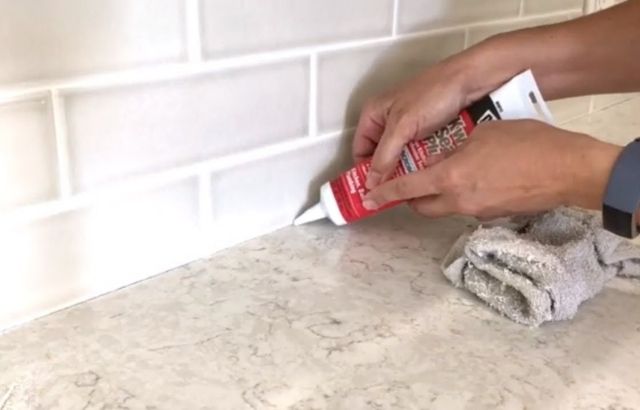Well! Your home is your paradise where you come after a long day at work and seek the peace of mind. It is the place where you want to have everything according to your preference and taste. When you are building your home and your bathroom or kitchen sink installed, a bead of caulk is applied around its perimeter for sealing gaps and protecting from leakage. If you use it properly, the caulk can last for many years, but there is a chance of it being crack or breakdown. So it is the best time to replace it, but “how to do it?” is a big question here. Luckily you can do this task on your own very quickly, and in this article on how to remove caulking from the countertop, we will guide you for this in detail.
What is caulking?
To prevent leaks in various constructions and pipelines, joints or seams are sealed using caulking. Fibrous materials are pushed into wedge-shaped cracks between boards on wooden ships and other structures to create the first kind of caulk. Historically, cast iron sewage pipes were caulked similarly.
The bulk of procedures involve cutting as well as scraping. You should cut the caulk into sections with a sharp putty knife or a razor blade, and then work the blade or tool under the sections you cut and pry them up. When the caulk breaks into sections, pull the areas off the laminate surface with pliers or with your fingers.
How to Remove Caulking from Countertop
Remove the existing caulk
To remove the caulk from the kitchen countertop and the bathroom sink, you’ll require some essential tools:
- Warm water.
- Acetone.
- Denatured Alcohol.
- Straight razor blade.
- Painter’s tool.
- Paper and towel.
- Cardboard or towel.
- If you have water-based caulks, you should start by soaking a warm water towel, as softening caulk for removal is a necessary step.
- Apply this to the existing caulk.
- This step will make the caulk soft, and the process will become easy to remove.
- Use denatured alcohol and acetone for removing silicone-based caulks to get the best results.
- As silicone caulk is the best sealant adhesive and waterproof, it is good to adopt for sealing the edges of countertop s at the wall’s meeting point.
- It is a long-lasting material, so it has to be replaced or removed for best results when it shows discoloration.
- Use the straight razor to cut and remove the excess caulk when once caulk is softened.
- You should be careful when dealing with the razor around certain surfaces.
- A stainless steel or metal sink can be damaged, whereas the porcelain sink can hold the pressure from a razor blade. Learn how to prevent water spots on stainless steel sink.
- The removing process can be time-consuming and needs patience, but it must be thorough in removing old caulk.
- If you do it properly, ensure proper adhesion of the new caulk to give it a better seal.
Application of new caulk:
- You should be sure about the right type of caulk before applying the new caulk.
- You will need a silicone-based caulk for the steel and metal-based sinks used in kitchens.
- But for a porcelain sink, latex-based caulk will be a good option.
- While buying caulk, it is necessary to select the color of the caulk that is matching to your place.
- You should use grey, tan, black or white caulk available in clear finish depending on the color and finish of countertops.
- The main objective of applying the caulk to sinks is to blend it with the surroundings.
- You should cut a small piece off the caulk tube’s tip, but opt for a caulk gun for the best results.
- Now, you can also use either caulking/painter’s tool for applying the caulk around the perimeter of the sink when the strip you have applied.
- You should do your best to limit the amount of exposure while applying the new caulk so that people won’t see the sealant. Therefore you should make a good application of it.
- When you apply the silicone-based caulk, the amount of material to be exposed should be limited to the counter’s surface so that, as a result, it will help produce a smooth appearance and seal the pores when it wets.
- If you want to give the best exposure to it, uses the painter’s tape along the edge when you start.
- You should follow the manufacturer’s instructions to apply and dry it while the new caulk application.
Now;
- It is best to wait for 24 hours for proper drying and not use the sink at this time.
- If you want to remove caulk from the wall, the best way is to loosen the acrylic caulk pieces by applying isopropyl alcohol.
- While the acrylic caulk is resistant to water, it will soften if exposed to alcohol.
- You should use the sponge to apply isopropyl alcohol to the area you removed caulk from, now allow alcohol to sit, absorbed, and dry by the old caulk.
- You can also remove caulk from grout using a utility knife or putty knife, slicing through the caulk and peeling it away.
- For multiple layers of caulk, needle-shaped pliers are best to work.
- There are also specialized caulk removal tools designed to tear away caulk from grout.
How to Clean Existing Caulk
- If your habit is cleaning caulk from the bathroom and kitchen sinks, you can stop the damage and mold very easily. Learn reglazing a kitchen sink.
- Every month you should use vinegar and water solution for silicone-based caulk if you want it to clean for best.
- If the strain is hard, you should leave it on the surface for 15 to 20 min before scrubbing it with a soft brush.
- If you want to remove silicone caulk from the window frame, use the knife to cut up the caulk.
- Use the alcohol-drenched rag to soften the remainder and remove with a sharp putty knife.
- If your interior windows are in the kitchen or the bathroom, you should try it pull out the caulk with fine pliers.
- The process to remove caulk residue is simple, but it takes some time and effort too.
- You should use the scraper or razor blade to clean off as much of the residue as possible without scratching the surface you want to clean.
- Now apply mineral spirits and denatured alcohol for getting the best results. Finally, brush away any bits that pill and become detached.
- The most effective method for cleaning the silicone film residue appears to be 1% if you use Tetrabutylammonium fluoride TBAF to solve Dowel propylene glycol methyl ether acetate before repainting a surface.
Now;
- There is a straightforward process to remove caulk from granite countertops.
- Acetone is the best option as a chemical caulk remover, as long as it isn’t poured directly on the granite or quartz countertops. If you do not know to cut Quartz countertop learn now.
- Pour the small amount on the soft, clean cloth and rub it into the silicone to lift the adhesive from the surface.
- Loctite 100% is a great top choice for this purpose.
- Similarly, you can remove caulk from joints with the help of a putty knife.
- It is the best tool for removing caulk from joints so that when the surface is suitable for work and removing loose or crumbling caulk.
- A putty knife is best for rough joint surfaces. However, it provides a poor cutting action.
Hire a professional
- Removal of old caulk and applying a new one to your bathroom sinks and kitchen countertops is essential for protecting them from damage and leak.
- You can also hire a professional’s services for removing band replacing the caulk from the bathroom and kitchen sinks and countertops.
Read More: How To Remove Kitchen Cabinets Without Damage
How to Remove Caulking from Countertop: FAQs
What will dissolve silicone caulk?
Vinegar and isopropyl alcohol can dissolve silicone caulk very easily. The best solution to remove silicone caulk short of using a detergent is to treat it with a silicone sealant remover, WD 40, vinegar, or alcohol; you should wait for it to soften and then do several hits with a knife or paint scraper.
How do you remove caulk without caulk remover?
There are few ways to remove caulk without using caulk remover. You can use a putty knife or utility knife, slicing through the caulk and peeling it away. For multiple layers of caulk, needle-nosed pliers work best. There is also special caulk removal tools designed to tear away caulk cleanly.
How do you remove caulk from the quartz countertop?
You can also remove caulk from the quartz countertop by simply cutting the silicone off with a razor blade. Gran Quartz 413 granite sealer is best for this. Once this has softened the silicone, carefully scrape it off. 000 steel wool and paper towels will finish the job.
Conclusion
To conclude how to remove caulking from the countertop, I recommend that though it is a somewhat tricky process, it will become easy if you complete it with some care and attention. Moreover, to get the job done properly, you will also need special tools and materials to avoid leakage and damage.




